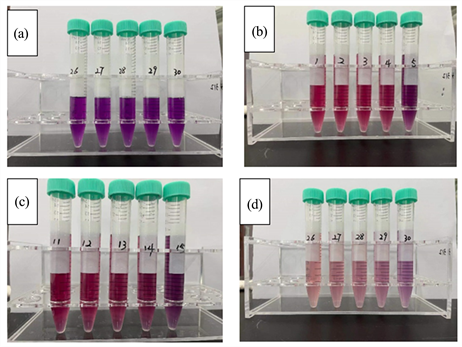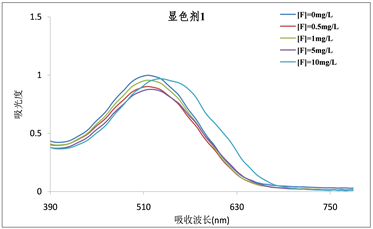Hans Journal of Medicinal Chemistry
Vol.
11
No.
04
(
2023
), Article ID:
76232
,
6
pages
10.12677/HJMCe.2023.114032
一种人体尿液中氟含量快速检测方法研究
陈艳1,冉晶锋1,汤海明2*
1贵州中医药大学药学院,贵州 贵阳
2贵州中医药大学基础医学院,贵州 贵阳
收稿日期:2023年10月6日;录用日期:2023年10月12日;发布日期:2023年11月28日

摘要
地方性氟中毒(又称地氟病)是与地理环境中氟的丰度密切相关的一种世界性地方性氟中毒,基本病征有氟斑牙、氟骨症以及非骨质氟中毒。贵州省特殊的环境特点使得贵州省成为我国受到地方性氟中毒最为严重的省份之一,区域内经济社会发展也因此受到限制。目前为止,对于地氟病并没有确实有效的治疗方案,因此对于地氟病则主要以防控措施为主,而制定针对地氟病的有效防控则需要建立准确的流行病调查结果。本文开发了一种能够现场快速检测受访者尿液中氟元素的显色检测方法,以实现对受访者进行快速筛查,提高患病人群的准确分类。
关键词
地方性氟中毒,尿液,快速筛查

Study on a Rapid Detection Method for Fluoride Content in Human Urine
Yan Chen1, Jingfeng Ran1, Haiming Tang2*
1School of Pharmacy, Guizhou University of Traditional Chinese Medicine, Guiyang Guizhou
2School of Basic Medicine, Guizhou University of Traditional Chinese Medicine, Guiyang Guizhou
Received: Oct. 6th, 2023; accepted: Oct. 12th, 2023; published: Nov. 28th, 2023

ABSTRACT
Endemic fluorosis is a worldwide endemic fluoride closely related to the abundance of fluoride in the geographical environment, and the basic symptoms are dental fluorosis, bone fluorosis, and non-bone fluorosis. The special environmental characteristics of Guizhou Province make Guizhou Province one of the provinces most seriously affected by endemic fluorosis in China, and the economic and social development in the region is also restricted. So far, there is no effective treatment plan for endemic fluorosis, so prevention and control measures are mainly used for endemic fluorosis, and the development of effective prevention and control of endemic fluorosis requires the establishment of accurate epidemiological investigations. In this paper, a chromogenic detection method that can rapidly detect fluoride in the urine of respondents in the field was developed to achieve rapid screening of respondents and improve the accurate classification of sick populations.
Keywords:Endemic Fluorosis, Urine, Rapid Detection

Copyright © 2023 by author(s) and Hans Publishers Inc.
This work is licensed under the Creative Commons Attribution International License (CC BY 4.0).
http://creativecommons.org/licenses/by/4.0/


1. 研究背景
地方性氟中毒(又称地氟病)是一定地区内环境中氟元素过多导致生活在环境中的人群摄入过量氟元素所引起的一种慢性全身性疾病 [1] ,临床表现为氟斑牙、氟骨症以及非骨质氟中毒(如脑、肝、肾等组织损伤) [2] [3] [4] [5] [6] 。地氟病还是一种世界性地方病,全球范围内主要流行于中国、印度、南非以及伊朗等国 [7] [8] ,在我国境内则主要流行于贵州、陕西、甘肃、山东、河北、辽宁、吉林、黑龙江等省。研究表明,地方性氟中毒暂无有效的治愈方法,因而地氟病控制主要以预防为主。在我国地氟病常见类型主要有以下三类:1) 饮水型氟中毒,饮水型氟中毒是发病范围最广、患病人数最多的类型;2) 燃煤型氟中毒,主要集中于我国西南地区;3) 饮茶型氟中毒,在我国西藏、四川和云南等部分地区流行 [1] [9] 。贵州省具有高氟的地质背景,使得贵州省成为我国受地氟病影响最严重的省份之一。调查数据显示,贵州省是我国典型燃煤型地氟病流行地区,全省患病人口近千万 [10] [11] 。近年来,随着贵州省经济社会的快速发展,城市化进程加快,原有生态环境发生巨变,可能使得氟元素向环境中的释放量增加 [12] [13] [14] 。因此,在燃煤型地氟病得以控制的情况下,我们仍需继续关注地氟病的发展趋势。
目前,人体尿液与血液中的氟含量测定主要采用氟离子选择电极进行 [15] [16] [17] 。该方法的优点在于:1) 对氟有很好的专一性,不易受其他离子影响;2) 灵敏度与准确度也很高,特别是优于过去的滴定检测法。该方法在实际运用中仍不够完美,主要体现在:1) 各项检测操作需要在实验室中进行,不能够在现场对被调查人群进行快速筛选分类;2) 若对某一地区进行流行病调查,需要进行的采样量巨大并且样品运输过程中存在污染风险;3) 对样品检测的精确度受人为因素影响较大。综上所述,在面向地方性氟中毒的调查研究过程中,我们还需要一种操作简单、快速对受访者进行筛选分类的检测方法,故此本研究采用了化学显色法检测人体尿液中的氟离子。
2. 方法实验
2.1. 仪器与试剂
PXSJ-216型离子计(配置PF-2-01型氟电极氟离子选择电极),上海雷磁生产;723PC紫外可见光分光光度计(1 cm石英池),上海菁光生产。
氟化钠、氯化钠、氢氧化钠,成都金山生产,AR;茜素氨羧络合剂,国药集团生产,AR;硝酸镧,国药集团生产,AR;二水合柠檬酸钠、冰乙酸、丙酮,科密欧化学试剂有限公司生产,AR;其他试剂均为市售分析纯试剂,无需纯化,直接使用。
2.2. 模拟尿液实验
利用模拟尿液(离子组成与浓度与人体尿液一致,溶解11.6 g氯化钠,2.0 g磷酸氢二氨[(NH4)2HPO4]于适量的水中,加1 mL浓硫酸,再用水稀释至1 L。)配置成5 ml含氟模拟尿液(模拟尿液中氟含量分别为0 mg/L、0.5 mg/L、1 mg/L、5 mg/L、10 mg/L)加入5 ml茜素氨羧络合剂–硝酸镧(茜素氨羧络合剂:0.001 mol/L;硝酸镧:0.001 mol/L;总离子强度缓冲溶液(TISAB)、丙酮),按照茜素氨羧络合剂与硝酸镧体积比1:1、2:1、1:2分别命名为显色剂1、显色剂2、显色剂3中进行显色实验,并使用紫外–可见光谱仪进行扫描。
2.3. 人体尿液实验
向收集的人体尿液中分别加入氟溶液配置成5 ml含氟尿液(尿液中氟含量分别为0.2 mg/L、0.4 mg/L、0.6 mg/L、1.0 mg/L、1.5 mg/L、2.5 mg/L、4.0 mg/L、5 mg/L),按照模拟尿液实验中筛选的显色剂,进行显色实验,并使用紫外–可见光谱仪进行扫描。
3. 结果与讨论
3.1. 模拟尿液实验结果
当含氟模拟尿液加入显色剂1之后,显色剂1随样品中的氟含量增加颜色变化不显著,仅在氟含量达到10.0 mg/L时,才出现明显的颜色变化。同样的现象,也出现在显色剂2中。而对于显色剂3,当氟离子加入显色剂之后,体系颜色明显变浅,并且随着氟离子浓度的升高,颜色逐渐变深。实验结果详见图1。

Figure 1. (a) Primary colors of chromogenic agents (1, 2, 3); (b) Color developer 1 color development experiment; (c) Color developer 2 color development experiment; (d) Color developer 3 color development experiment. The tube numbers in the figure are from low to high, and the distribution represents the fluoride content in simulated urine 0 mg/L, 0.5 mg/L, 1.0 mg/L, 5.0 mg/L, and 10.0 mg/L
图1. (a) 显色剂(1、2、3)原色;(b) 显色剂1显色实验;(c) 显色剂2显色实验;(d) 显色剂3显色实验。图中试管编号由低到高,分别代表模拟尿液中氟含量为0 mg/L、0.5 mg/L、1.0 mg/L、5.0 mg/L、10.0 mg/L
对上述不同氟含量的模拟尿液加入显色剂1、显色剂2以及显色剂3的体系进行紫外–可见光谱扫描,实验结果详见图2。显色剂1在可见光区的吸光度只是随着氟含量的增加而减小(这种可能是稀释效应导致的变化),仅在氟含量达到10.0 mg/L时才出现红移现象。对于显色剂2在可见光区范围内,在较低氟浓度出现吸光度随浓度增加而减小的情况。当氟离子浓度不断升高时,波长出现了显著的红移现象,且吸光度保持稳定,而当氟含量达到10.0 mg/L时,吸光度出现显著的减弱,吸收波长也回到原始点。而对于显色剂3,我们发现随着氟离子的加入吸光度出现显著减弱,随着氟离子浓度的增加吸光度出现略微的增加,同时当氟含量达到10.0 mg/L时,吸收波长也出现了略微的红移现象。通过以上模拟尿液实验,显色剂1对于模拟尿液(离子组成一致)的氟离子浓度响应较好,故此确定使用显色剂1真实尿液的实验。



Figure 2. Scanning results of ultraviolet-visible light spectrometer in urine of color developer 1, color developer 2, color developer 3 were simulated by adding different fluorine concentrations
图2. 显色剂1、显色剂2、显色剂3加入不同氟浓度模拟尿液中紫外–可见光光谱仪扫描结果
3.2. 人体尿液实验结果
以模拟尿液中的显色剂1进行改进后进行人体尿液的测试,分别调整显色剂中总离子强度缓冲剂(增强显色剂掩蔽其他离子的能力)制备显色剂① (茜素氨羧络合剂:硝酸镧:TISAB:丙酮 = 1:1:2:1),调整显色剂1中的丙酮含量(增强显色剂的溶解能力) 制备得显色剂② (茜素氨羧络合剂:硝酸镧:TISAB:丙酮 = 1:1:1:2)。将调整后的显色剂加入人体尿液中进行显色实验,实验结果如图3所示。通过显色实验发现,随着尿液中氟离子浓度升高,两种显色剂的颜色也随之变深,但在较低浓度氟离子含量时,显色剂①的颜色的变化深度要明显优于显色剂②。当尿液中氟离子浓度达到5.0 mg/L时,则达到显色极限。我们认为丙酮作为良溶剂,其含量的增加导致显色剂溶解能力较强,是的显色效果变浅,同时TISAB作为总离子浓度调节剂,其含量的增加能增强对其他杂质离子的掩蔽作用,使得显色效果加强,这也导致显色剂①的显色效果明显优于显色剂②。

Figure 3. (a) Color rendering effect of the color developer ①; (b) Color rendering effect of the color developer ②
图3. (a) 显色剂①显色效果;(b) 显色剂②显色效果
同样对上述不同氟含量的模拟尿液加入显色剂①和显色剂②的体系进行紫外–可见光谱扫描,实验结果详见图4。从紫外–可见光光谱图中不难发现,显色剂①的吸光度明显低于显色剂②,这与肉眼观察到的现象一致,显色剂①呈现的颜色明显于显色剂②。同时,随着尿液中氟含量的升高,两种显色剂的吸光度呈现出先增加,当在某一浓度时,吸光度又逐渐降低。从实验的浓度梯度设置来看,显色剂①在达到2.5 mg/L时,吸光度达到最大,而显色剂②在达到1.5 mg/L时,达到最大吸光度,故此我们认为显色剂①较显色剂②具有更宽的氟离子响应范围,更好的显色效果。

Figure 4. Ultraviolet-visible light spectrogram of color developer ① and color developer ②
图4. 显色剂①与显色剂②紫外–可见光光谱图
4. 结论
通过本项研究,我们发现,利用茜素氨羧络合剂、硝酸镧、总离子强度缓冲溶液(TISAB)、丙酮配置的显色剂可以对人体尿液中的氟离子进行有效显色,同时以茜素氨羧络合剂:硝酸镧:TISAB:丙酮 = 1:1:2:1比例配置的显色剂能够很好地对含有不同氟离子含量的人体尿液进行快速的显色反应。本研究的方法操作简单、试剂要求低,可用于地氟病调查中的快速检测与筛查。
基金项目
贵州省卫生健康委科学技术基金项目(gzwkj2021-419)。
文章引用
陈 艳,冉晶锋,汤海明. 一种人体尿液中氟含量快速检测方法研究
Study on a Rapid Detection Method for Fluoride Content in Human Urine[J]. 药物化学, 2023, 11(04): 273-278. https://doi.org/10.12677/HJMCe.2023.114032
参考文献
- 1. McGill, P.E. (1995) Endemic Fluorosis. Baillière’s Clinical Rheumatology, 9, 75-81. https://doi.org/10.1016/S0950-3579(05)80145-1
- 2. Nagendra, A.H., Najar, M.A., Bose, B., et al. (2022) High Concentration of Sodium Fluoride in Drinking Water Induce Hypertrophy versus Atrophy in Mouse Skeletal Muscle via Modulation of Sarcomeric Proteins. Journal of Hazardous Materials, 432, Article ID: 128654. https://doi.org/10.1016/j.jhazmat.2022.128654
- 3. Maheshwari, N., Qasim, N., Anjum, R. and Mahmood, R. (2021) Fluoride Enhances Generation of Reactive Oxygen and Nitrogen Species, Oxidizes Hemoglobin, Lowers Antiox-idant Power and Inhibits Transmembrane Electron Transport in Isolated Human Red Blood Cells. Ecotoxicology and En-vironmental Safety, 208, Article ID: 111611. https://doi.org/10.1016/j.ecoenv.2020.111611
- 4. Pan, X.L., Yan, W.M., Qiu, B., et al. (2020) Aberrant DNA Methylation of Cyclind-CDK4-p21 Is Associated with Chronic Fluoride Poisoning. Chemico-Biological Interactions, 315, Article ID: 108875. https://doi.org/10.1016/j.cbi.2019.108875
- 5. Aulestia, F.J., Groeling, J., Bomfim, G.H.S., et al. (2020) Fluoride Exposure Alters Ca2+ Signaling and Mitochondrial Function in Enamel Cells. Science Signaling, 13, eaay0086. https://doi.org/10.1126/scisignal.aay0086
- 6. Johnston, N.R. and Strobel, S.A. (2020) Principles of Fluoride Toxicity and the Cellular Response: A Review. Archives of Toxicology, 94, 1051-1069. https://doi.org/10.1007/s00204-020-02687-5
- 7. Dehbandi, R., Moore, F. and Keshavarzi, B. (2018) Geochemi-cal Sources, Hydrogeochemical Behavior, and Health Risk Assessment of Fluoride in an Endemic Fluorosis Area, Cen-tral Iran. Chemosphere, 193, 763-776. https://doi.org/10.1016/j.chemosphere.2017.11.021
- 8. Kurdi, M.S. (2016) Chronic Fluorosis: The Disease and Its Anaesthetic Implications. Indian Journal of Anaesthesia, 60, 157-162. https://doi.org/10.4103/0019-5049.177867
- 9. Chen, M., Yuan, Y.L., Luo, J.Z., et al. (2011) Notice of Retraction: Fluorine in Drinking Water and Endemic Fluorosis in Northern China. 2011 5th International Conference on Bioinfor-matics and Biomedical Engineering, Wuhan, 10-12 May 2011, 1-4. https://doi.org/10.1109/icbbe.2011.5780847
- 10. 汪希兰, 高嘉宇, 李晨, 等. 贵州省燃煤污染型地方性氟中毒病区人群氟暴露水平变化[J]. 环境与健康杂志, 2020, 37(7): 620-622.
- 11. Li, Y.-H., Wang, W.Y., Yang, L.S. and Li, H.R. (2014) Environmental Epidemic Characteristics of Coal-Burning Endemic Fluorosis and the Safety Thresh-old of Coal Fluoride in China. Fluoride, 36, 106-112.
- 12. 喻艳琴, 张秀秀, 田薇, 等. 贵州省西部燃煤型地氟病区8~14岁农村小学生营养不良和氟斑牙调查[J]. 贵州医科大学学报, 2020, 45(1): 13-17.
- 13. Li, Y., Bi, Y.H., Mi, W.J., et al. (2021) Land-Use Change Caused by Anthropogenic Activities Increase Fluoride and Arsenic Pollution in Groundwater and Human Health risk. Journal of Hazardous Materials, 406, Article ID: 124337.
- 14. https://doi.org/10.1016/j.jhazmat.2020.124337
- 15. Yuan, L., Fei, W., Jia, F., et al. (2020) In-creased Health Threats from Land Use Change Caused by Anthropogenic Activity in an Endemic Fluorosis and Arsenic-osis Area. Environmental Pollution, 261, Article ID: 114130.
- 16. https://doi.org/10.1016/j.envpol.2020.114130
- 17. Porcaro, F., Roudeau, S., Carmona, A. and Or-tega, R. (2018) Advances in Element Speciation Analysis of Biomedical Samples Using Synchrotron-Based Techniques. TrAC Trends in Analytical Chemistry, 104, 22-41. https://doi.org/10.1016/j.trac.2017.09.016
- 18. 张惠敏, 吴彦城, 尤嘉宜, 等. 氟离子荧光探针设计、合成与应用的新进展[J]. 有机化学, 2016, 36(11): 2559-2582.
- 19. 杨小东, 汪磊, 路新卫, 等. 一种用于氟离子可视化检测的荧光探针[J]. 华南理工大学学报(自然科学版), 2014, 42(10): 90-94.
NOTES
*通讯作者。